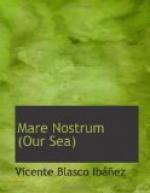“You are in the navy,” he said suddenly.
And the count assented, judging dissimulation useless.
Yes, he was a naval officer.
“Then what am I doing here? Why have you given the command to me?...” So Ferragut was thinking without discovering why this man should seek his assistance when he could direct a boat himself, without any outside aid.
Undoubtedly he was a naval officer, and all the blonde sailors that were working like automatons must also have come from some fleet. Discipline was making them respect Ferragut’s orders, but the captain suspected that for them he was merely a proxy, the true chief on board being the count.
The schooner passed within sight of the Liparian archipelago; then, twisting its course toward the west, followed the coast of Sicily, from Cape Gallo to the Cape of Vito. From there it turned its prow to the southeast, heading toward the Aegadian Islands.
It had to wait in the waters where the Mediterranean was beginning to narrow between Tunis and Sicily, where the volcanic peak of the Pantellarian Island rises up in the middle of the immense strait.
Brief indications from the count were sufficient to make the course followed by Ferragut in accordance with his desire. He finally could not hide his admiration for the Spaniard’s mastery of navigation.
“You know your sea well,” said the count.
The captain shrugged his shoulders, smiling. It truly was his. He could call it “mare nostrum” just as the Romans and their former rulers had done.
As though divining the subsea depths by a simple glance, he kept his boat within the limits of the extensive ledge of the Aventura. He was navigating slowly with only a few sails, crossing and recrossing the same water.
Kaledine, after two days had passed by, began to grow uneasy. Several times it sounded to Ferragut as though he were muttering the name of Gibraltar. The passage from the Atlantic to the Mediterranean was the greatest danger for those that he was expecting.
From the deck of the schooner he was able to see only a short distance, and the count clambered up the rigging in order that his eyes might take in a more extensive sweep.
One morning up aloft he called something to the captain, pointing out a speck on the horizon. He must steer in that very direction. What he was seeking was over there.
Ferragut obeyed him, and half an hour later there appeared, one after the other, two long, low boats, moving with great velocity. They were like destroyers, but without mastheads, without smokestacks, skimming along almost on a level with the water, painted in a gray that made them seem a short distance away of the same color as the sea. They came around on both sides of the sailboat as though they were going to crush it with the meeting of their hulls. Various metallic cables came up from their decks and were thrown over the bitts of the schooner, fastening it to them, and forming the three vessels into a solid mass that, united, followed the slow undulation of the sea.




